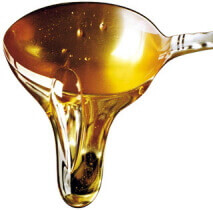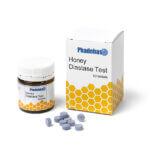According to the EU Honey Directive, certain composition criteria must be determined for honeys intended for human consumption. Diastase enzyme activity (diastase number) is one; others are Sugar-, Moisture- and Water-insoluble content, Electrical conductivity, Free acid, and hydroxymethylfurfural (HMF) content. The International Honey Commission (IHC) was formed in 1990 in order to create a new world honey standard. Some of the current objectives of the IHC are;
- To work out better and new analysis methods of honey and the other bee products
- To inform members of the group on current aspects of quality and control of honey and other bee products
To help meet their goals, the IHC has compiled a host of validated and harmonised methods. The official analysis methods for the determination of Diastase Activity in honey are the Schade and Phadebas® assays, as recommended by IHC. The EU Honey Directive states that when marketed for human consumption, honey must meet the following criteria for Diastase activity (Schade units):
- In general not less than 8 (except baker’s honey);
- Honeys with low natural enzyme content (e.g. citrus honeys) and an hydroxymethylfurfural HMF content of not more than 15 mg/kg: not less than 3.
 Diastase in honey converts starch to short-chain sugars and the enzymes’ activity hints at possible heating and/or poor storage conditions. Heating the honey degrades the enzyme, which is why the EU directive states minimum values. In the U.S., diastase activity is mainly controlled to ensure low Diastase values, because much of the honey supply is used at bakeries for mixing with starch-containing food ingredients. A high Diastase number may cause poor bread texture. Regardless of the objective, measuring Diastase activity is important.
Diastase in honey converts starch to short-chain sugars and the enzymes’ activity hints at possible heating and/or poor storage conditions. Heating the honey degrades the enzyme, which is why the EU directive states minimum values. In the U.S., diastase activity is mainly controlled to ensure low Diastase values, because much of the honey supply is used at bakeries for mixing with starch-containing food ingredients. A high Diastase number may cause poor bread texture. Regardless of the objective, measuring Diastase activity is important.
The original Phadebas method uses the reagents of the Phadebas Amylase Test. However, analysing honey samples wasn’t the intended use of this product and problems were soon reported by vigilant laboratories. To meet the demands for analysing honey, a new product was developed together with European laboratories. The result was the Phadebas® Honey Diastase Test.
Phadebas® Honey Diastase Test is a diversification from the original Phadebas® Amylase Test. Honey Diastase Test is intended for determination of diastase activity in honey and nothing but honey. Diastase activity given by this method is based on fixed equations determined through a study comparing the original Schade method with one specific batch of Phadebas Amylase Test tablets. The method was developed and is recommended by the International Honey Commission. However, since there may be differences in reactivity between Phadebas Amylase Test batches, using predetermined equations will lead to varying results. For other Phadebas applications this is not a problem as quantification is based on the batch specific standard curve supplied with each kit. Adding to this problem, the change of dye in the Phadebas reagent also caused a change in the assay sensitivity.
Phadebas Honey Diastase Test is developed in accordance to ISO 9001. The result is a product with very narrow specifications wherein all batches of Phadebas Honey Diastase Test will behave alike and adhere to the set of equations in the IHC guidelines.
 The more modern Phadebas® IHC method offers a faster and simpler format with greatly improved precision. The assay’s analytical performance is robust and thoroughly scrutinized by several interlaboratory trials. Today it’s largely replacing the older Schade method, as it offers better precision, improved selectivity and an improved through-put. Phadebas Honey Diastase Test is as an improved and cost effective alternative to the Schade method with;
The more modern Phadebas® IHC method offers a faster and simpler format with greatly improved precision. The assay’s analytical performance is robust and thoroughly scrutinized by several interlaboratory trials. Today it’s largely replacing the older Schade method, as it offers better precision, improved selectivity and an improved through-put. Phadebas Honey Diastase Test is as an improved and cost effective alternative to the Schade method with;
– better precision
– improved selectivity
– fewer reagents
– fewer steps (less laborious)
– less labour time.
